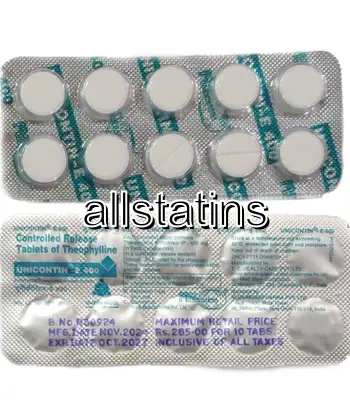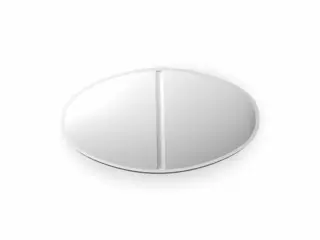Buy Theophylline Online in the USA at All Statins
| Package | Dosage | Price | Price per Dose | |
|---|---|---|---|---|
| Dosage: 400mg | ||||
| 360 pill | 400mg | $459.25 | $1.27 | |
| 180 pill | 400mg | $249.35 | $1.38 | |
| 120 pill | 400mg | $182.97 | $1.52 | |
| 90 pill | 400mg | $152.47 | $1.69 | |
| 60 pill | 400mg | $114.80 | $1.92 | |
| 30 pill | 400mg | $69.95 | $2.35 | |

Theophylline Description
Overview of Theophylline
Theophylline is a medication primarily used to treat respiratory conditions such as asthma, chronic obstructive pulmonary disease (COPD), and other related disorders. It belongs to a class of drugs known as methylxanthines, which work by relaxing the muscles in the airways, allowing for easier airflow. This mechanism helps improve breathing and reduces symptoms like wheezing, shortness of breath, and coughing. Theophylline has been in medical use for many decades and remains a valuable option for managing certain respiratory conditions, especially when other treatments are insufficient or contraindicated.
Effectiveness and Benefits
Many patients report significant relief from respiratory symptoms when using Theophylline. Its bronchodilator properties make it effective in opening narrowed airways, which is especially beneficial during acute exacerbations of lung diseases. Theophylline also has a modest anti-inflammatory effect, although it is not primarily used for its anti-inflammatory properties. Additionally, some patients find that Theophylline helps improve exercise tolerance and overall respiratory function. It is often prescribed as part of a comprehensive treatment plan, alongside inhaled corticosteroids or bronchodilators, to optimize breathing and quality of life.
Administration and Dosage
Theophylline is available in various forms, including tablets, capsules, and liquid formulations. The dosing schedule is usually individualized based on the patient’s age, weight, and clearance rate. Due to its narrow therapeutic window, careful monitoring of blood levels is essential to avoid toxicity. Healthcare providers often start with a low dose and gradually adjust it to reach the desired therapeutic level. Patients are advised to take the medication consistently and adhere strictly to the prescribed regimen to ensure safety and effectiveness.
Potential Side Effects
Like all medications, Theophylline can cause side effects. Mild side effects may include nausea, vomiting, stomach upset, headache, or restlessness. More serious adverse effects are less common but can occur, especially if blood levels become too high. These may include rapid heartbeat, tremors, seizures, confusion, or severe gastrointestinal symptoms. Regular blood testing is crucial to maintain safe levels of the medication. Patients should inform their doctor immediately if they experience any unusual or severe symptoms.
Precautions and Interactions
Before starting Theophylline, patients should provide their healthcare provider with a full list of medications and health conditions. Theophylline can interact with various drugs, including certain antibiotics, antidepressants, and other bronchodilators. These interactions can alter the drug’s effectiveness or increase the risk of side effects. Patients with a history of heart problems, liver or kidney disease, or gastrointestinal issues should discuss these conditions with their doctor. Lifestyle factors, such as smoking or caffeine intake, can also influence how the drug works and may necessitate dosage adjustments.
Conclusion
Theophylline remains an important medication in respiratory therapy. Its proven efficacy in improving breathing makes it a valuable option for many patients with chronic lung conditions. Proper dosing, regular monitoring, and awareness of potential side effects are vital to ensure safe and effective therapy. Patients should always follow their healthcare provider’s instructions and report any concerns promptly to maintain optimal health and respiratory function.
See Also


